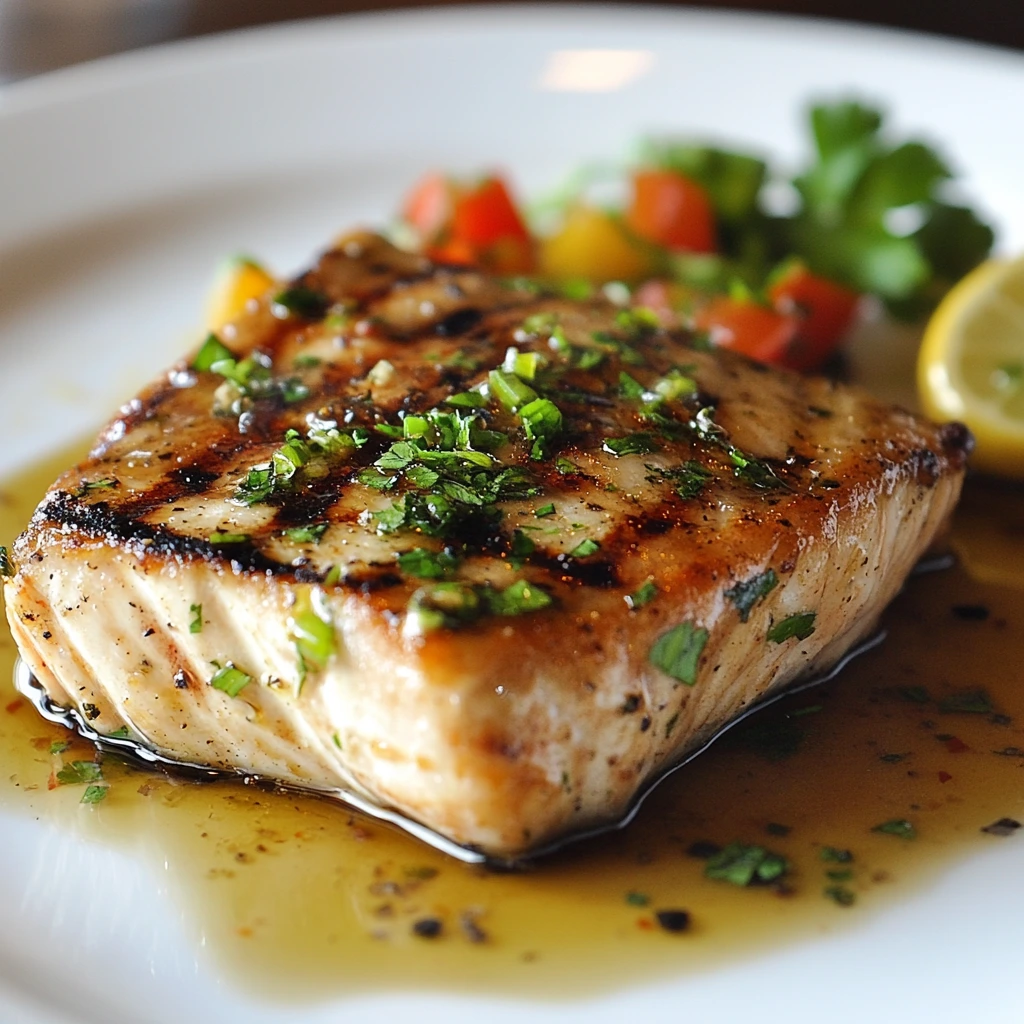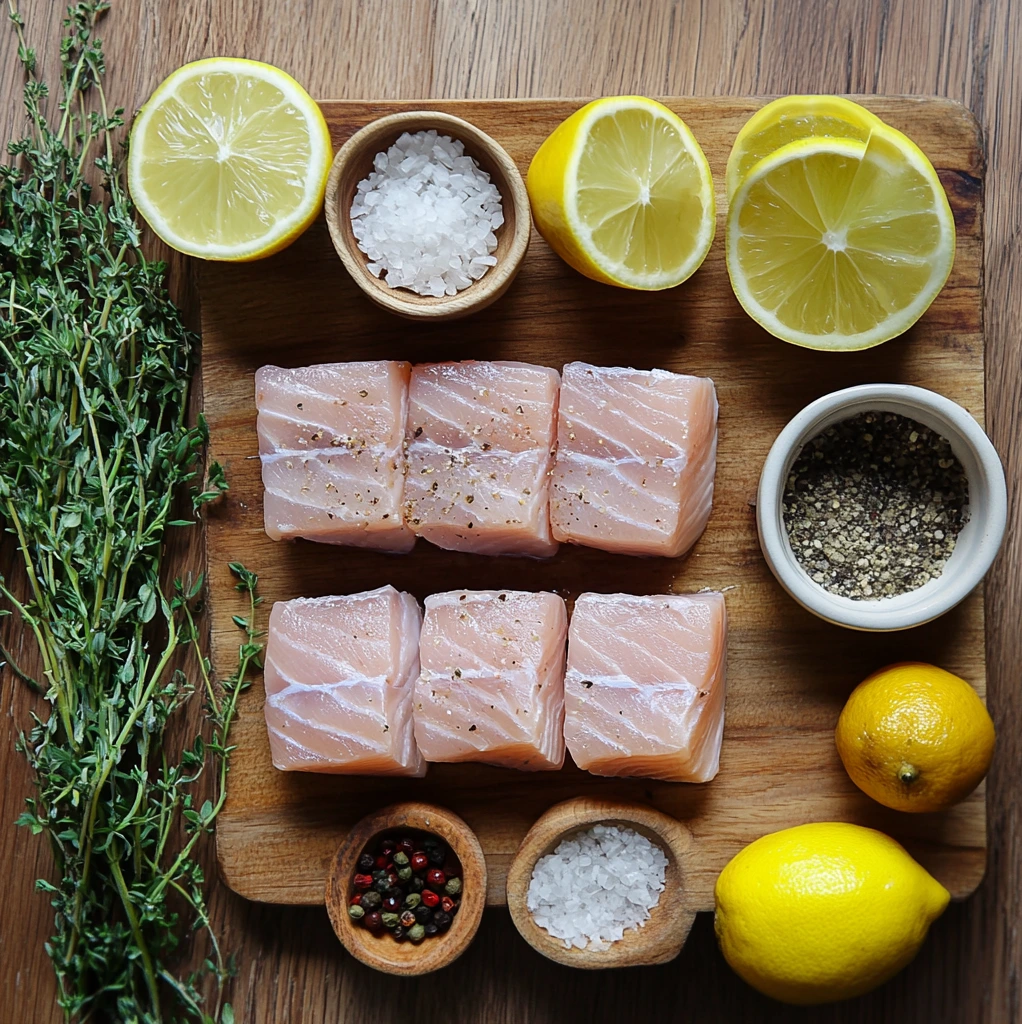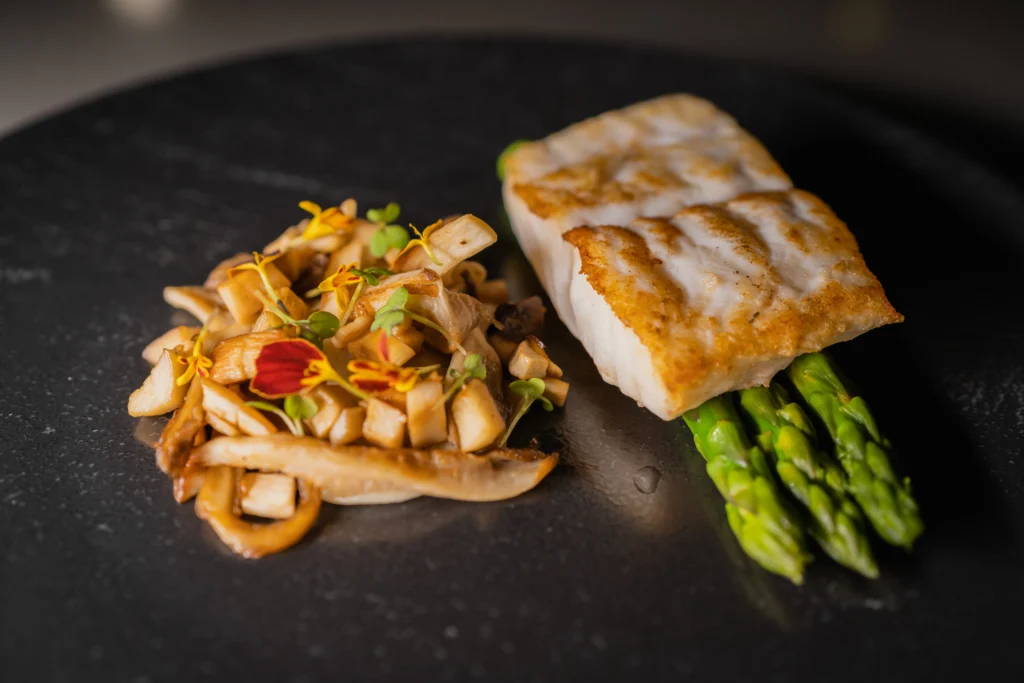Looking for a simple yet delicious seafood dish to impress your family or guests? This Swordfish Steak Recipe with Lemon, Garlic, and Olive Oil is the perfect choice! With its tender, meaty texture and flavorful combination of zesty lemon, fragrant garlic, and rich olive oil, this dish is both healthy and satisfying. Whether you’re a seasoned chef or a beginner in the kitchen, this recipe is easy to follow and will bring the taste of the Mediterranean right to your table. Let’s dive into this mouthwatering recipe that promises to deliver a burst of fresh flavors with every bite!

Introduction to Swordfish Steak
Swordfish is a robust, meaty fish that offers a unique alternative to more commonly consumed seafood like salmon or tuna. Its firm texture and mild flavor make it ideal for grilling, pan-searing, or even broiling. Unlike other fish that can have a delicate, flaky texture, swordfish holds up well to a variety of cooking methods, making it versatile in the kitchen.
One of the best things about swordfish is its ability to absorb bold flavors. In this recipe, the bright tang of lemon, the richness of garlic, and the smoothness of olive oil come together to elevate the fish’s natural taste without overpowering it. The result is a beautifully balanced dish that’s light yet satisfying, perfect for a healthy weeknight dinner or a special occasion meal.
In addition to its delicious taste, swordfish is also packed with nutrients. It is an excellent source of lean protein, omega-3 fatty acids, and essential vitamins like vitamin D and B12. These nutrients support heart health, boost the immune system, and contribute to overall well-being, making swordfish a nutritious and tasty choice for anyone looking to eat well.
Whether you’re new to cooking seafood or a seasoned chef, swordfish is a fantastic fish to add to your repertoire. Its versatility and health benefits make it an appealing option for anyone looking to explore new flavors while maintaining a balanced diet.

Ingredients You’ll Need for This Recipe
For this simple yet flavorful swordfish steak recipe, you’ll need a few key ingredients to bring out the best in the fish while keeping it healthy and easy to prepare. Here’s everything you need:
1. Fresh Swordfish Steaks
- The star of the dish! Choose fresh, thick swordfish steaks with a firm texture. Swordfish is typically sold in steaks, which makes it perfect for grilling or pan-searing. Look for steaks that are deep pink or coral-colored with minimal browning. Freshness is key, as it helps retain the fish’s meaty texture and rich flavor.
2. Olive Oil
- A high-quality extra virgin olive oil is essential for this recipe. Olive oil will not only help in cooking the swordfish but will also impart a rich, smooth flavor that complements the fish perfectly. The healthy fats in olive oil also enhance the overall nutritional profile of the dish.
3. Fresh Lemon
- Lemon adds a zesty kick to the swordfish, balancing the richness of the olive oil and enhancing the fish’s natural flavor. Freshly squeezed lemon juice gives the dish a bright, refreshing taste that elevates the whole recipe. You’ll also want some lemon zest to sprinkle over the fish at the end for an extra burst of citrusy goodness.
4. Garlic
- Garlic is a must-have for this recipe. Its aromatic, savory flavor works wonderfully with the swordfish, adding a depth of taste that complements the brightness of the lemon and the richness of the olive oil. Fresh garlic is recommended for maximum flavor, but pre-minced garlic can also work in a pinch.
5. Seasonings
- Salt and Pepper: Simple but crucial for bringing out the flavors of the fish. A pinch of sea salt and freshly cracked black pepper will help season the swordfish and balance the other ingredients.
- Optional Seasonings: Depending on your preference, you might also consider adding some dried herbs, such as thyme, oregano, or parsley, to sprinkle on the swordfish before cooking. These herbs pair beautifully with the Mediterranean flavors of this dish.
6. Fresh Herbs (Optional)
- A few sprigs of fresh herbs, such as parsley or thyme, can be used as a garnish to add color and a fresh, herbal note to the finished dish. This not only makes the dish visually appealing but also adds a burst of extra flavor.

How to Prepare the Swordfish Steaks
Preparing swordfish steaks is simple and straightforward, and with just a few key steps, you’ll have the perfect base for your delicious meal. Here’s how to prep the swordfish to ensure it’s full of flavor and ready to cook:
1. Choosing Fresh Swordfish Steaks
- When selecting swordfish, look for steaks that are firm and moist, with a clean, fresh smell. The color should be a rich, pink or coral hue. Avoid steaks with any browning or dullness, as this can indicate age. Fresh swordfish will have a slightly translucent quality, especially along the edges. If you’re able to, ask your fishmonger for the freshest cuts available.
2. Patting the Swordfish Steaks Dry
- Before marinating or seasoning, it’s important to pat the swordfish steaks dry with paper towels. Excess moisture can interfere with the cooking process, causing the fish to steam instead of sear or grill. Drying the steaks ensures you get a beautiful caramelized crust when cooking.
3. Marinating the Swordfish (Optional)
- While swordfish has a naturally mild and meaty flavor, marinating it for 15-30 minutes before cooking can help enhance its taste. For this recipe, combine the olive oil, lemon juice, minced garlic, salt, and pepper in a shallow dish. Coat the swordfish steaks with the marinade, making sure both sides are well-covered. Allow the fish to marinate in the refrigerator for a brief period to absorb the flavors.
Tip: If you’re short on time, you can skip the marinating step and simply drizzle the olive oil and lemon mixture directly onto the swordfish before cooking.
4. Seasoning the Swordfish Steaks
- Once marinated or ready to cook, season the swordfish with freshly cracked black pepper and a pinch of salt. This will help balance the bold flavors of garlic and lemon. You can also add some dried herbs like thyme or oregano if you prefer an herby note. Sprinkle the herbs directly on the steaks, or use them in the marinade.
5. Letting the Fish Rest
- Before cooking, let the swordfish steaks rest at room temperature for 10–15 minutes. This helps the fish cook evenly and prevents the exterior from becoming too tough while the inside remains cold. Allowing the steaks to come to room temperature also ensures they will cook through without drying out.

Cooking Swordfish: Grilling vs. Pan-Seared
Swordfish is a versatile fish that can be cooked in various ways, but grilling and pan-searing are two of the best methods for bringing out its natural flavors. Both techniques create a beautifully charred exterior while keeping the inside juicy and tender. Here’s a breakdown of each method to help you choose which one works best for you:
1. Grilling Swordfish
Grilling swordfish steaks brings out a smoky, charred flavor that complements its meaty texture. It’s an excellent option if you’re aiming for that outdoor, Mediterranean-style experience. Here’s how to grill your swordfish steaks perfectly:
- Preheat the Grill: Start by preheating your grill to medium-high heat. If you’re using a charcoal grill, make sure the coals are hot and glowing. A gas grill should be at a steady temperature of around 400°F (200°C).
- Oil the Grill Grates: To prevent sticking, brush your grill grates with a little olive oil. You can use a paper towel dipped in oil or a grill brush to coat the surface.
- Grill the Swordfish Steaks: Place the swordfish steaks on the grill and cook them for about 4-5 minutes per side, depending on the thickness of the steaks. You should see clear grill marks forming on the fish. Try not to move the steaks too much during grilling to allow for those beautiful marks to form.
- Check for Doneness: Swordfish should be cooked to an internal temperature of about 145°F (63°C). The fish should flake easily with a fork, but still remain moist and slightly opaque in the center. Avoid overcooking, as swordfish can become dry if left on the grill too long.
- Optional Garnish: After grilling, you can drizzle a little extra olive oil, squeeze fresh lemon juice, and sprinkle some fresh herbs like parsley or thyme for added flavor.
2. Pan-Seared Swordfish
Pan-searing swordfish creates a golden-brown crust that adds depth to the fish’s natural flavor. This method is great when you want a quick and easy way to cook swordfish indoors, especially when the weather doesn’t allow for grilling. Here’s how to pan-sear swordfish:
- Preheat the Pan: Heat a non-stick skillet or cast-iron pan over medium-high heat. Add 1-2 tablespoons of olive oil to the pan and let it heat until shimmering but not smoking.
- Cook the Swordfish Steaks: Once the oil is hot, place the swordfish steaks in the pan. Allow them to cook without moving them for about 4-5 minutes on the first side. This will help create a crispy, golden crust. Flip the steaks carefully using tongs or a spatula and cook the other side for an additional 3-4 minutes, depending on thickness.
- Check for Doneness: Just like grilling, the internal temperature of the fish should reach 145°F (63°C). The swordfish should be firm to the touch but still moist inside.
- Optional Basting: To enhance the flavor, you can baste the swordfish steaks with the pan’s oil and cooking juices. Add a couple of tablespoons of butter and a sprig of thyme or rosemary to the pan during the last minute of cooking, spooning the melted butter over the fish for added richness.
3. Which Method to Choose?
- Grilling: If you prefer a smoky, slightly charred flavor and are cooking outside or want that classic BBQ feel, grilling is your best bet. It’s ideal for summer cookouts and when you want to impress guests with a stunningly presented dish.
- Pan-Searing: If you’re cooking indoors or want more control over the cooking process, pan-searing is a great option. It’s quicker and allows for a deliciously crisp crust, all while keeping the fish moist inside.
Both methods yield delicious results, so it ultimately comes down to personal preference and what equipment you have available. Whichever you choose, swordfish will shine as the centerpiece of your meal with a perfect balance of flavors and textures!
Serving Suggestions and Pairing Ideas
Once your swordfish steaks are perfectly cooked, it’s time to think about how to serve and pair them to create a well-rounded meal. The rich, savory flavors of the swordfish combined with the zesty lemon, garlic, and olive oil make it a versatile dish that pairs well with a variety of sides and beverages. Here are some fantastic serving suggestions and pairing ideas:
1. Best Sides to Serve with Swordfish
- Roasted Vegetables: Roasted vegetables, such as asparagus, zucchini, bell peppers, and cherry tomatoes, are a great complement to swordfish. The slight caramelization from roasting brings out the natural sweetness of the vegetables, while their textures provide a nice contrast to the tender fish.
- Mediterranean Quinoa or Couscous: A light grain salad made with quinoa or couscous is an excellent side for swordfish. Toss it with fresh herbs like parsley, mint, and dill, and add a touch of lemon juice and olive oil for a Mediterranean flair. The light, fluffy grains pair well with the meaty texture of the swordfish.
- Garlic Mashed Potatoes: If you’re craving something heartier, creamy garlic mashed potatoes make a comforting side. The rich, buttery texture of the mashed potatoes balances out the acidity of the lemon and the savory garlic flavor from the swordfish.
- Green Salad: A simple mixed greens salad with arugula, spinach, or baby kale dressed in a lemon vinaigrette is a refreshing choice. The slight bitterness of the greens pairs wonderfully with the rich fish, and the light dressing adds just the right amount of acidity to balance the dish.
- Rice Pilaf: A fragrant rice pilaf with herbs and a touch of lemon zest is another excellent pairing. The subtle flavors of the rice allow the swordfish to remain the star of the meal while adding a satisfying, slightly nutty complement.
2. Wine Pairings
Swordfish, with its meaty texture and citrusy, garlicky notes, pairs beautifully with a variety of wines, particularly those that complement the richness of the fish while balancing the acidity of the lemon. Here are some great wine options to serve alongside your swordfish steak:
- White Wine:
- Sauvignon Blanc: A crisp, refreshing Sauvignon Blanc with citrus and herbal notes will match the lemon and garlic flavors in the swordfish, providing a zesty contrast to the fish’s richness.
- Chardonnay (unoaked): An unoaked Chardonnay with bright acidity and a clean, crisp finish pairs well with the fish without overpowering it. Its subtle fruitiness enhances the lemony marinade without clashing with the fish’s meaty texture.
- Rosé Wine: A dry, fruity rosé, especially one with a good balance of acidity, can work wonders with swordfish. The delicate fruit flavors and crisp finish of rosé make it a versatile pairing for seafood, especially dishes like swordfish with lemon and garlic.
- Red Wine (Light-bodied):
- Pinot Noir: If you prefer red wine, go for a light-bodied Pinot Noir. Its smooth tannins and fresh berry flavors won’t overpower the fish and will complement the grilled or pan-seared elements of the dish.
3. Additional Garnishing and Finishing Touches
- Lemon Wedges: Serve extra lemon wedges on the side for guests who want an extra burst of citrus. A squeeze of fresh lemon can brighten up the dish and enhance the flavors.
- Fresh Herbs: Finishing your swordfish steaks with freshly chopped herbs such as parsley, thyme, or basil adds a pop of color and freshness. You can even add a few sprigs of rosemary or thyme to the pan during the last minute of cooking for added fragrance.
- Olives or Capers: If you’re looking to add a briny, Mediterranean touch, a few olives or capers can be a great finishing garnish. Their salty, tangy flavors pair beautifully with the mild swordfish and the lemony marinade.
- Chili Flakes (Optional): For a little heat, a pinch of red chili flakes can be sprinkled on top of the swordfish before serving. This adds a subtle spicy kick that contrasts nicely with the lemon and olive oil.
4. Serving Suggestions for a Complete Meal
- For a Casual Meal: Serve the swordfish steaks with a side of roasted vegetables and a chilled glass of Sauvignon Blanc for a light, refreshing dinner. This is perfect for a relaxed weeknight meal with family or friends.
- For a Special Occasion: If you’re preparing swordfish for a special occasion, consider pairing it with a Mediterranean grain salad, a glass of crisp rosé, and a simple green salad with a lemon vinaigrette. This combination creates a balanced, elegant meal that will impress your guests.
Table of Contents
Edit Post “Quick and Easy Plum Jelly Recipe from Scratch” ‹ labelrecipes.com — WordPress
Gordon Ramsay’s Swordfish Was the Peaceful Dinner I Didn’t Know I Needed – Chef Ramsay Recipes


1 thought on “Swordfish Steak Recipe with Lemon, Garlic, and Olive Oil”